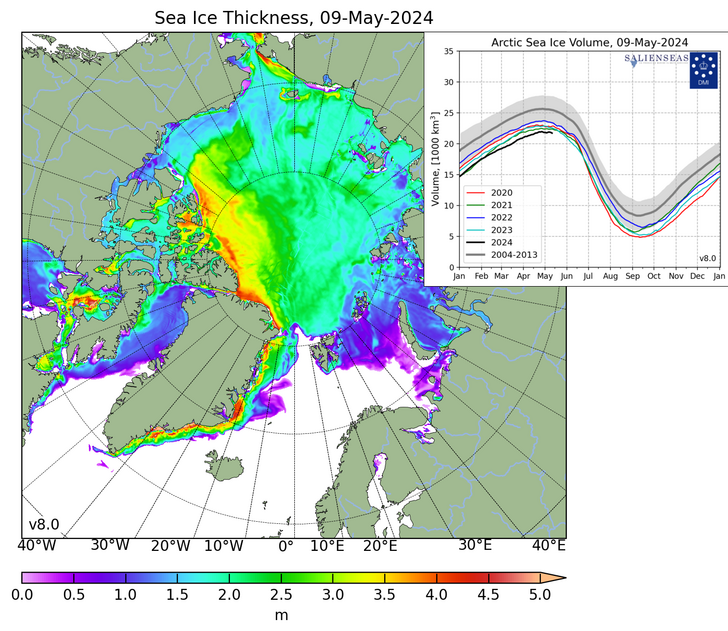

Date:
The map, animation and graph illustrate the sea ice thickness in the Northern Hemisphere, excluding the Baltic Sea and the Pacific. The data is based on DMI’s model calculations.
The map is updated on a daily basis.
In order to get a true picture of the state of the sea ice, it is necessary to determine both its extent and its volume. This includes the thickness of the ice, which can vary from thin ice to ice that is several metres thick.
We have improved the DMI operational ocean and sea-ice model HYCOM-CICE with higher horizontal resolution and updated HYCOM and CICE code. In particular, the sea ice code has been greatly improved with meltponds, sea-ice salinity, improved thermodynamics and much more. The freshwater discharge from Greenland has also been greatly improved using freshwater product from GEUS, which especially improves the coastal ocean currents and thus the ice transport nearshore Greenland. The model has been running continuously since September 1990. Therefore, we have by December 07, 2021 updated the graphics of sea-ice thickness and volume using the new and improved data on Polarportal and ocean.dmi.dk.
The improved model setup has led to higher variability as well as less adrupt melting during the melt season, which gives a shift of approximately half a month for the time of minimum ice volume. The trend between the years is almost unchanged. Thereby, a year with a large sea-ice volume in the old setup also has a large volume in the new setup, and similar for years with low sea-ice volume.
The ice cover in the Arctic grows throughout the winter, before peaking in March. Melting picks up pace during the spring as the sun gets stronger, and in September the extent of the ice cover is typically only around one third of its winter maximum.
Differences may occur in terms of the position of the edge of the ice in the two maps, “Extent of the sea ice” and “Thickness and volume of the sea ice”, as the model calculations do not always correspond exactly to the satellite sensors’ registration of the extent of the ice.
Ice concentrations are based on satellite data and are from the Ocean and Sea Ice Satellite Application Facility project (OSISAF).
The thickness of the ice shown is calculated by means of the HYCOM-CICE model of sea ice at DMI. The model calculates various oceanographic values, including sea ice, in a grid with cells of 10 x 10 square km. The model is driven by meteorological data from ECMWF (European Centre for Medium-Range Weather Forecasts). In each grid cell the ice is classified into 5 thickness categories, with thickness, concentration, movement and heat balance of the ice being calculated for each category. The map of the ice thickness shows the mean thickness of ice in each grid cell.
The graph on the right shows the annual variation of the volume of the sea ice in the Northern Hemisphere, excluding the Baltic Sea and the Pacific. The volume of the ice is calculated on the basis of the ice thicknesses from the HYCOM-CICE model. In each grid cell the volume is calculated as thickness multiplied with concentration and with area, with contributions from all grid cells to the total volume. The grey band around the climatologic mean value corresponds to plus/minus one standard deviation based on the 10-year average 2004-2013.